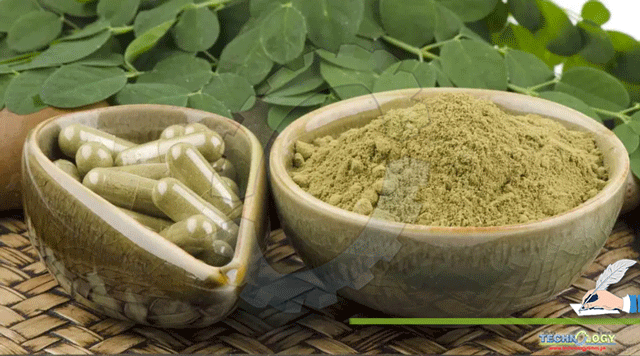Moringa oleifera, which originated in India, has spread over many tropical locations, including the Pacific, West Africa, Central America, and the Caribbean.

By Mehfooz-ul-haq, Filza Ishfaq, Muhammad Asif, Hira Ikram, Tehreem Fatima, Muhammad Amir, Maria Naqvi, Safura Bibi, Muhammad Anjum Zia, Athar Mahmood
It’s a multi-purpose plant that’s utilised for medical, food, and feed applications. Moringa seeds have been used to extract oil, curry powder, and filter water, among other things. In some places of Vietnam, moringa leaves are consumed. Moringa agronomic trials in Tinh Bien district, An Giang province, show that the plant can thrive in hilly areas with worn, low-fertility soils.
Moringa leaves are known for being high in protein and low in anti-nutrients. Grass as a sole source of nutrition for goats is not advised due to its low protein content. Moringa foliages, as a result, could be a low-cost protein source. The leaves of Leucaena, which are regarded to be particularly nutritious, are swiftly devoured by animals.
BOTANICAL DESCRIPTION:
Classification:
The preffered scientific names of Drumsticks tree plantae (kingdom), Dicotyledonae (class), Moringaceae (family), Horse Radish tree (English name), Shaigaru, Shajan, Munga (Hindi name), Sohanjana (Urdu name), Moringa (Genus), olifera (species)
Common names of Moringa
- English: (Horse) radish tree, Drumstick tree, Mother`s best friend, West Indian ben
- Spanish: Ben, Arbol del ben, Morango, Moringa
- French: Ben aile, Benolive, Moringa
Moringa oleifera pod husk antimicrobial study in vitro and phytoconstituents Phytomedicine is regaining popularity as a result of its advantages over conventional drugs and the increased incidence of drug resistance. The antibacterial properties of Moringa oleifera pod husks are investigated in vitro, and potent phytoconstituents against Gram positive and Gram negative bacteria, as well as yeast infections, are identified. Except in a few cases where Staphylococcus aureus, Staphylococcus epidermidis, Salmonella typhimurium 1, Escherichia coli, and Klebsiella pneumoniae 1 belong to the two major groups of bacteria and have a similar MIC value of 400 mg/l, the MIC values differed between species
In Gram positive bacteria like Staphylococcus epidermidis and Enterococcus faecalis, as well as Gram negative bacteria like Klebsiella pneumoniae 2 and Salmonella typhimurium 2, the acetone extract induced longer PAE when compared to ciprofloxacin. The biosafety assays for mutagenicity and toxicity at 300 mg/l and 4000 mg/l dosages were negative. The most abundant phytoconstituents were found to be alkaloids, flavonoids, tannins, diterpenes, triterpenes, and cardiac glycosides. Flavonoids and diterpenes demonstrated inhibitory effects against all test organisms except Klebsiella pneumoniae 2 and Candida tropicalis. As a result, M. oleifera pod husks, which are usually considered agri-residues, have the potential to develop broad-spectrum drugs or therapeutic approaches, including multidrug-resistant bugs, which are currently a big issue.
A comparison of the nutritional quality of Moringa oleifera leaves and seed protein The goal of this study was to determine the nutritional value of Moringa oleifera seeds and leaves as a source of protein. Protein and carbs were abundant in the defatted flours (33.53 and 18.63 percent for seeds and leaves, respectively). All essential amino acids were found in both the leaf and seed flours, with a high concentration of leucine and valine and a low content of methionine and cysteine. Leaf flour had a greater total essential amino acid content (42.76 g/16 g N) than seed flour (35.07 g/16 g N). Lysine and sulphur amino acids were shown to be limiting amino acids. Leaf flour had a much greater
accessible lysine content (3.78 g/16 g N) than seed flour (1.30 g/16 g N). In vitro digestibility tests demonstrated that pepsin digested leaf proteins more easily than seed proteins. Furthermore, digestibility of seed flour (61.12 percent) was significantly higher than that of leaf flour after pepsin-pancreatin hydrolysis (57.22 percent). Furthermore, the leaf flour outperformed the seed flour in terms of chemical score (72.40%), protein efficiency ratio (3.47–3.71), protein digestibility corrected amino acid score (41.42%), and accessible lysine (3.78 g/16 g N). As a result, M. oleifera seeds and leaves have a lot of promise as dietary supplements or food additives.
Moringa oleifera has numerous health advantages
Moringa oleifera is a multi-purpose herbal plant that is utilised as a human food and a therapeutic alternative all over the world. Essential amino acids, carotenoids in the leaves, and components and excellent constituents in food preparation are all found in Moringa oleifera. It has a wide spectrum of essential antioxidants, antibiotics, and nutrients, including vitamins and minerals, which make it useful in medicine.
Moringa oleifera cultivation and marketing One of the most beneficial plants is Moringa oleifera. Almost every part of the tree is useful in some way, and people in both rural and urban areas rely on it. Though the moringa tree is found throughout the tropics, it is commonly utilised as a barrier around farms, particularly in Northern Nigeria. There have been few attempts to commercialise the tree for the other products: oil for cosmetic and edible purposes, natural coagulant from the seeds, and other ancillary uses from virtually all parts of the plant, with the exception of medium scale cultivation of the tree in Nigeria for the production of leaves as an alternative green vegetable source for human nutritional and other medicinal uses. Despite the key difficulties outlined, research indicates that moringa is a feasible investment. The viability possibilities, when broken down further into specifics like processing, are even better with a net return of N11,965,000.00 per ha per year, with a breakeven yield of 1,295kg/ha and a profitability index of 2.047 per ha per year.